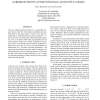Free Online Productivity Tools
i2Speak
i2Symbol
i2OCR
iTex2Img
iWeb2Print
iWeb2Shot
i2Type
iPdf2Split
iPdf2Merge
i2Bopomofo
i2Arabic
i2Style
i2Image
i2PDF
iLatex2Rtf
Sci2ools
ICIP
2004
IEEE
2004
IEEE
Markerless motion capture with single and multiple cameras
The aim of Optical Motion Capture is to sequentially estimate the true state X of the subject (generally an articulated body) at any time instant tk from a set of data Dk, captured by N calibrated cameras each of resolution U ?V pixels. Our aim is to achieve this without the need for markers. This is to enhance both utility and portability for the motion capture system and to render it suitable for surveillance issues. Even though several stochastic techniques to address this issue exist, we aim to solve this problem in a deterministic way, for future real-time performance. We adopt a Bayesian framework under which we employ a 3D articulated model M and a rendering function to describe the data. Unlike other existing approaches [1, 2], we solely use silhouette matching to obtain a measure of how well the model describes the data.
Articulated Body | Deterministic Way | Future Real-time Performance | ICIP 2004 | Image Processing | Optical Motion Capture | Time Instant Tk |
Related Content
| Added | 24 Oct 2009 |
| Updated | 24 Oct 2009 |
| Type | Conference |
| Year | 2004 |
| Where | ICIP |
| Authors | Paris Kaimakis, Joan Lasenby |
Comments (0)

